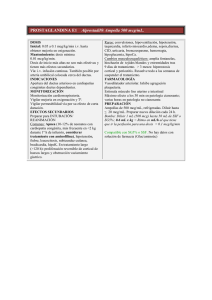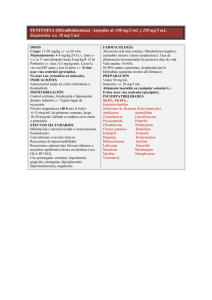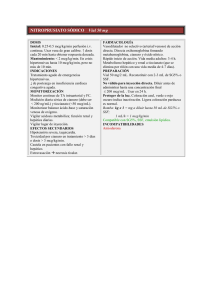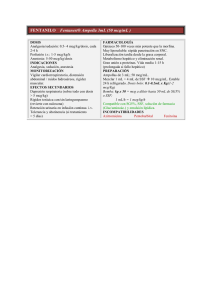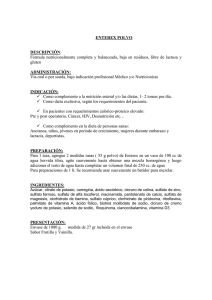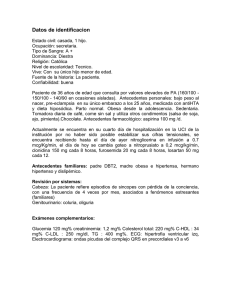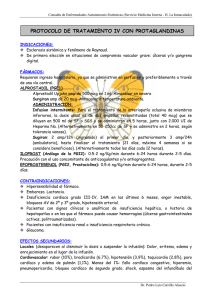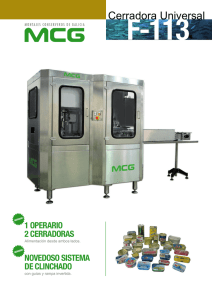aplicación práctica de los nomogramas de remifentanil y propofol
Anuncio
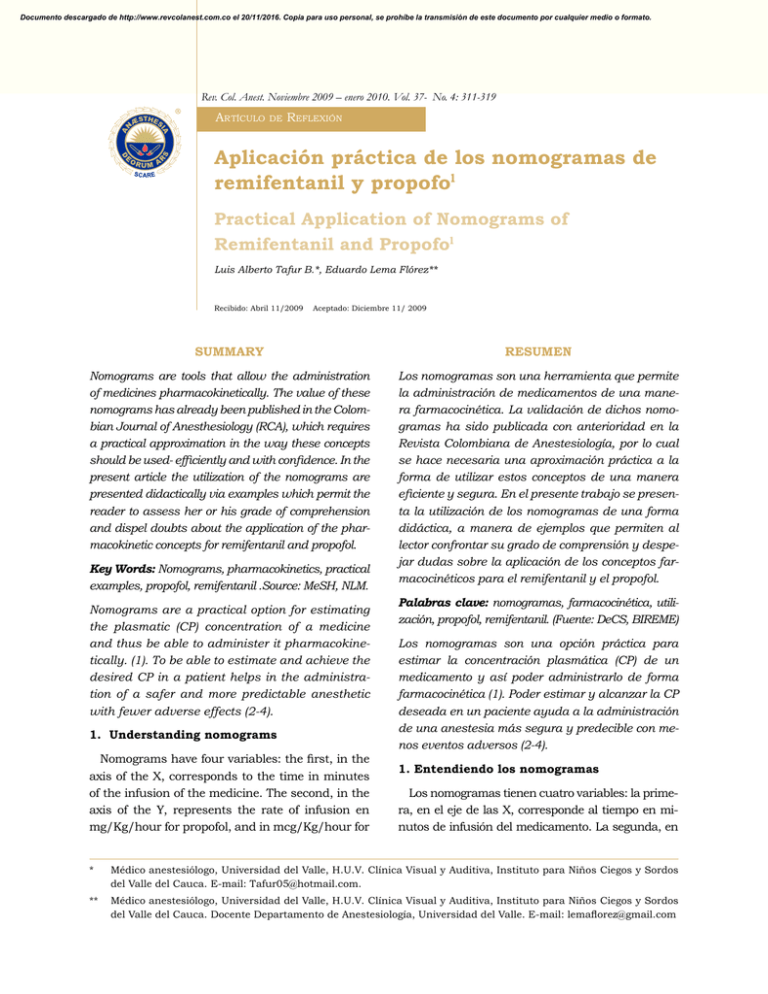
Documento descargado de http://www.revcolanest.com.co el 20/11/2016. Copia para uso personal, se prohíbe la transmisión de este documento por cualquier medio o formato. Practical Application of Nomograms of Remifentanil and Propofol Aplicación práctica de los nomogramas de remifentanil y propofol 311 Rev. Col. Anest. Noviembre 2009 – enero 2010. Vol. 37- No. 4: 311-319 Artículo de reflexión aplicación práctica de los nomogramas de remifentanil y propofol Practical application of nomograms of remifentanil and Propofol Luis Alberto Tafur B.*, Eduardo Lema Flórez** Recibido: Abril 11/2009 Aceptado: Diciembre 11/ 2009 Summary reSumen Nomograms are tools that allow the administration of medicines pharmacokinetically. The value of these nomograms has already been published in the Colombian Journal of Anesthesiology (RCA), which requires a practical approximation in the way these concepts should be used- eficiently and with conidence. In the present article the utilization of the nomograms are presented didactically via examples which permit the reader to assess her or his grade of comprehension and dispel doubts about the application of the pharmacokinetic concepts for remifentanil and propofol. Los nomogramas son una herramienta que permite la administración de medicamentos de una manera farmacocinética. La validación de dichos nomogramas ha sido publicada con anterioridad en la Revista Colombiana de Anestesiología, por lo cual se hace necesaria una aproximación práctica a la forma de utilizar estos conceptos de una manera eiciente y segura. En el presente trabajo se presenta la utilización de los nomogramas de una forma didáctica, a manera de ejemplos que permiten al lector confrontar su grado de comprensión y despejar dudas sobre la aplicación de los conceptos farmacocinéticos para el remifentanil y el propofol. Key Words: Nomograms, pharmacokinetics, practical examples, propofol, remifentanil .Source: MeSH, NLM. Nomograms are a practical option for estimating the plasmatic (CP) concentration of a medicine and thus be able to administer it pharmacokinetically. (1). To be able to estimate and achieve the desired CP in a patient helps in the administration of a safer and more predictable anesthetic with fewer adverse effects (2-4). 1. understanding nomograms Nomograms have four variables: the irst, in the axis of the X, corresponds to the time in minutes of the infusion of the medicine. The second, in the axis of the Y, represents the rate of infusion en mg/Kg/hour for propofol, and in mcg/Kg/hour for * ** Palabras clave: nomogramas, farmacocinética, utilización, propofol, remifentanil. (Fuente: DeCS, BIREME) Los nomogramas son una opción práctica para estimar la concentración plasmática (CP) de un medicamento y así poder administrarlo de forma farmacocinética (1). Poder estimar y alcanzar la CP deseada en un paciente ayuda a la administración de una anestesia más segura y predecible con menos eventos adversos (2-4). 1. entendiendo los nomogramas Los nomogramas tienen cuatro variables: la primera, en el eje de las X, corresponde al tiempo en minutos de infusión del medicamento. La segunda, en Médico anestesiólogo, Universidad del Valle, H.U.V. Clínica Visual y Auditiva, Instituto para Niños Ciegos y Sordos del Valle del Cauca. E-mail: [email protected]. Médico anestesiólogo, Universidad del Valle, H.U.V. Clínica Visual y Auditiva, Instituto para Niños Ciegos y Sordos del Valle del Cauca. Docente Departamento de Anestesiología, Universidad del Valle. E-mail: [email protected] Documento descargado de http://www.revcolanest.com.co el 20/11/2016. Copia para uso personal, se prohíbe la transmisión de este documento por cualquier medio o formato. 312 Rev. Col. Anest. Noviembre 2009 – enero 2010. Vol. 37- No. 4: 310-320 remifentanil. Administration in hours and not in minutes aids a rapid calculation, given that the infusion pumps for the most part are programmed in ml/hour. The curved lines represent the plasmatic concentrations (see igure 1 and 2). For the remifentanil nomogram the straight lines represent concentration according to age. In the inferior extreme, are the 80-year-old patients, and in the superior, the 20-year-olds. The proportional division of these lines allows the placement of different ages. As such, the middle point represents patients of 50 years of age. 2. remifentanil nomogram The following step consists of establishing which is the desired CP according to the procedure. According to different studies, these are (5-6): CP Intubation* = 7 – 8 ng/ml CP Thorax surgery* = 6 -7 ng/ml CP Abdominal surgery* = 5 - 6 ng/ml CP Bland tissues* = 3.5 - 4 ng/ml CP De-tubing* = 3 – 3.5 ng/ml CP Sedation = 2 - 3 ng/ml *Plasmatic concentrations combined with a hypnotic. Figura 1. Nomograma Remifentanil: Modelo Minto el eje de las Y, representa la tasa de infusión en mg/ Kg/hora para el propofol, y en mcg/Kg/hora para el remifentanil. La administración en horas, y no en minutos, ayuda a un cálculo rápido dado que las bombas de infusión, en su mayoría, se programan en ml/ hora. Las líneas curvas representan las concentraciones plasmáticas (ver igura 1 y 2). Para el nomograma de remifentanil las líneas rectas representan la concentración según la edad. En el extremo inferior, los pacientes con 80 años, y en el superior, los de 20. La división proporcional de estas líneas permite ubicar las diferentes edades. Así, el punto medio representaría a los pacientes con 50 años. 2. nomograma de remifentanil El siguiente paso consiste en establecer cuál es la CP deseada según el procedimiento. De acuerdo con diferentes estudios, éstas son (5-6): CP Intubación* = 7 – 8 ng/ml CP Cirugía de tórax* = 6 -7 ng/ml CP Cirugía de abdomen* = 5 - 6 ng/ml CP Tejidos blandos* = 3,5 - 4 ng/ml CP Extubación* = 3 - 3,5 ng/ml CP Sedación = 2 - 3 ng/ml *Concentraciones con un hipnótico. plasmáticas combinadas Figura 2. Nomograma Propofol: Modelo Marsh Documento descargado de http://www.revcolanest.com.co el 20/11/2016. Copia para uso personal, se prohíbe la transmisión de este documento por cualquier medio o formato. Practical Application of Nomograms of Remifentanil and Propofol Aplicación práctica de los nomogramas de remifentanil y propofol 313 The following are some examples regarding the way to utilize nomograms during anesthesia. The method of preparing remifentanil is a choice for each anesthesiologist, keeping in mind that upon utilizing high concentrations the quantity of remifentanil per ml that is found stored in extension is a risk factor for the patient who goes into recuperation. In the examples 2 mg of remifentanil diluted in 500 ml of SSN (4 mcg/ml) are utilized. example 1 (see igure 1). In the case of a patient 30 years old weighing 70 kilograms, which remifentanil infusion would be appropriate to achieve an objective of 7 to 8 ng/ml in plasma for the intubation? Observing the remifentanil nomogram (see igures 1), the rhombus (20 years), the square (50 years) and the circle (80 years)- yellow- found on the thread, represent the plasmatic concentration between 7 and 8 ng/ml after six minutes’ infusion. As such, between the extremes of 20 and 80 years the different ages can be placed. Every time there is a patient 30 years old, she or he will need an infusion of 30 mcg/K/hour in six minutes in order to achieve the desired objective (see igures 6, red arrow). 30 (mcg/kg/hour) x 70 kg = 2100 mcg/hour A continuación se presentan ejemplos sobre cómo utilizar los nomogramas durante la anestesia. La forma de preparación del remifentanil es una elección de cada anestesiólogo, teniendo en cuenta que al utilizar concentraciones altas la cantidad de remifentanil por ml que se encuentra almacenado en la extensión es un factor de riesgo para el paciente que sale a recuperación. En los ejemplos se utilizarán 2 mg de remifentanil diluidos en 500 ml de SSN (4 mcg/ml). ejemplo 1 (ver igura 1). Para el caso de un paciente de 30 años, con 70 kilogramos de peso, ¿cuál será la infusión de remifentanil para alcanzar un objetivo de 7 a 8 ng/ml en plasma para la intubación? Observando el nomograma de remifentanil (ver iguras 1), el rombo (20 años), el cuadrado (50 años) y el círculo (80 años) de color amarillo, que se encuentran ubicados en una hilera, representan la concentración plasmática entre 7 y 8 ng/ ml después de seis minutos infusión. Así, entre los extremos de 20 y 80 años se pueden ubicar las diferentes edades. Toda vez que el paciente tiene 30 años de edad, necesitará una infusión de 30 mcg/K/hora en seis minutos para alcanzar el objetivo deseado (ver igura 6, lecha roja). Since the concentration for this example is 4 mcg/ml: (2100 mcg/hour) / (4 mcg/ml) = 525 ml/hour The irst rate of infusion is adjusted to 525 ml/ Figura 3. Ubicación en la concentración plasmática de 5 ng/ml de remifentanil a la edad de 30 años y su respectiva tasa de infusión en el eje de las Y, línea punteada. Figure 3. Pinpointing the plasmatic concentration of remifentanil, 5 ng/ml at the age of 30 and the respective rate of infusion in the axis of the Y, pointed line. Figura 5. Ubicación del punto C de la línea roja (2 mcg/ ml) y su tasa de infusión correspondiente al eje de las Y 5m2 mg/Kg/hora. (Flecha azul a la izquierda) Figure 5. Pinpointing of point C of the red line (2 mcg/ ml) and the infusión rate corresponding to the axis of the Y 5m2 mg/Kg/hour. (Blue arrow on the left) Documento descargado de http://www.revcolanest.com.co el 20/11/2016. Copia para uso personal, se prohíbe la transmisión de este documento por cualquier medio o formato. 314 Rev. Col. Anest. Noviembre 2009 – enero 2010. Vol. 37- No. 4: 310-320 hour in order to infuse 52 ml. Where do these 52 ml come from? Since the infusion should take six minutes, and this span of time is 10% of 60 minutes (1 hour), then: 525 ml/hour x 10% hour = 52 ml. Therefore, each time the rate of infusion for intubation in 6 minutes is calculated, one divides the rate of infusion per hour based on 10 and one gets the volume to infuse. Extrapolating the data of the nomogram one observes that the intubation doses in six minutes for the different ages are the following: 20 years – 33 mcg/Kg/h 30 years – 30 mcg/Kg/h 40 years – 27 mcg/kg/h 50 years – 24 mcg/kg/h 60 years – 22 mcg/kg/h 70 years – 20 mcg/kg/h 80 years – 18 mcg kg/h example 2. For the same patient readied for a laparoscopic cholecystectomy (abdominal surgery), what is the rate of infusion necessary to maintain a CP of 5 ng/ml? In the remifentanil nomogram (see igure 1), the straight lines represent the desired CP: violet line 1 ng/ml; green line 3 ng/ml; blue line 5 ng/ml; yellow line 7 ng/ml, and red line 9ng/ml. The CP of 2, 4, 6 and 8 ng/ml would be represented by a straight line equidistant between the superior and inferior CP. For the example, one must choose the blue line (5 ng/ml). On this line the patient’s age is graphed (see igure 3) and the rate of infusion per hour that corresponds to the axis in the Y is chosen; in this case, 14 mcg/kg/hour. (14 mcg/Kg/hour) x 70 Kg = 980 mcg/hour. Since the concentration of remifentanil is 4 mcg/ml, then: (980 mcg/hour) / (4 mcg/ml) = 245 ml/hour. The infusión pump should be programed to 245 ml/hour to achieve a CP approximately 5 ng/ml. 30 (mcg/kg/hora) x 70 kg = 2100 mcg/hora Como la concentración para este ejemplo es de 4 mcg/ml: (2100 mcg/hora) / (4 mcg/ml) = 525 ml/h Se ajusta la primera tasa de infusión a 525 ml/hora para que le infunda 52 ml. ¿De dónde resultan estos 52 ml? Como la infusión se debe pasar en seis minutos, y este tiempo es el 10% de 60 minutos (1 hora), entonces: 525 ml/hora x 10% hora = 52 ml. Por lo tanto, cada vez que se calcule la tasa de infusión para intubación en 6 minutos, basta con dividir la tasa de infusión por hora entre 10 y se obtiene el volumen a infundir. Extrapolando los datos del nomograma se tiene que las dosis de intubación en seis minutos para las diferentes edades son las siguientes: 20 años – 33 mcg/Kg/h 30 años – 30 mcg/Kg/h 40 años – 27 mcg/kg/h 50 años – 24 mcg/kg/h 60 años – 22 mcg/kg/h 70 años – 20 mcg/kg/h 80 años – 18 mcg kg/h ejemplo 2. Para el mismo paciente que será llevado a una colecistectomía laparoscópica (cirugía abdominal), ¿cuál es la tasa de infusión para mantener una CP de 5 ng/ml? En el nomograma de remifentanil (ver igura 1), las líneas rectas representan las CP que se desea alcanzar: línea violeta 1 ng/ml, línea verde 3 ng/ ml, línea azul 5 ng/ml, línea amarilla 7 ng/ml, línea roja 9 ng/ml. Las CP de 2, 4, 6 y 8 ng/ml estarían representadas por una línea recta equidistante entre las CP superior e inferior. Para el ejemplo, se debe elegir la línea azul (5ng/ml). En ésta se ubica la edad del paciente (ver igura 3), y se elige la tasa de infusión por hora que le corresponde en el eje de las Y, en este caso, 14 mcg/kg/hora. (14 mcg/Kg/hora) x 70 Kg = 980 mcg/hora. Como la concentración de remifentanil es de 4 mcg/ml, entonces: (980 mcg/hora) / (4 mcg/ml) = 245 ml/hora. Documento descargado de http://www.revcolanest.com.co el 20/11/2016. Copia para uso personal, se prohíbe la transmisión de este documento por cualquier medio o formato. Practical Application of Nomograms of Remifentanil and Propofol Aplicación práctica de los nomogramas de remifentanil y propofol 315 Figura 4. Ubicación en la concentración plasmática de 3 ng/ml de remifentanil a la edad de 30 años y su respectiva tasa de infusión en el eje de las Y, (línea punteada). Figure 4. Pinpointing the plasmatic concentration of remifentanil, 3 ng/ml at the age of 30 and the respective rate of infusion in the axis of the Y (pointed line). example 3. For the same case and at the moment of de-tubing the patient with the least incidence of cough possible, a CP between 3 and 3.5 ng/ml of remifentanil and a MAC between 0.1 and 0.2 of any halogenated or CP of propofol approximately 1.5 mcg/ml are required. What is the per hour rate of infusion of remifentanil required in order to maintain the desired CP? For this CP the green line (3ng/ml) is placed according to the patient’s age, resulting in a rate of infusion per hour that corresponds to the axis of the (Y), being 8.5 mcg/kg/hour (see igure 4). Keeping in mind the effectiveness according to the context of remifentanil, this infusion must be adjusted approximately 10 minutes before awakening. (8.5 mcg/Kg/hour) x 70 Kg = 595 mcg/hour. Since the concentration of remifentanil for this example is 4 mcg/ml, then: (595 mcg/hour) / 4 mcg/ml = 149 ml/hour. The rate of infusión of the pump is 149ml/ hour in order to de-tube the patient with the least incidence of cough. 3. Propofol nomogram Therefore, as it is necessary to know what remifentanil CP is required in accordance with the moment of surgery and the type of intervention, it is also imperative to know which propofol CP is adequate: Debe programarse la bomba a 245ml/hora para alcanzar una CP aproximada de 5 ng/ml. ejemplo 3. Para el mismo caso, y al momento de retirar el tubo de la traquea al paciente con la menor incidencia de tos posible, se requiere una CP de entre 3 y 3,5 ng/ml de remifentanil y un MAC (Concentración alveolar mínima) de entre 0,1 y 0,2 de cualquier halogenado o CP de propofol alrededor de 1,5 mcg/ml. ¿Cuál es la tasa de infusión por hora de remifentanil requerida para mantener la CP deseada? Para esta CP se ubica la línea verde (3ng/ml) de acuerdo con la edad del paciente, encontrando que la tasa de infusión por hora que le corresponde en el eje de las (Y) es de 8,5 mcg/kg/ hora (ver igura4). Teniendo en cuenta la vida media según contexto del remifentanil, ésta infusión debe ser ajustada aproximadamente 10 minutos antes de despertar. (8,5 mcg/Kg/hora) x 70 Kg = 595 mcg/hora. Como la concentración de remifentanil para este ejemplo es de 4 mcg/ml, entonces: (595 mcg/hora) / 4 mcg/ml = 149 ml/hora. La rata de infusión de la bomba es de 149ml/ hora para poder retirar el tubo de la traquea al paciente con la menor incidencia de tos. 3. nomograma de propofol Así como es necesario conocer qué CP de remifentanil se requiere de acuerdo con el momento de la cirugía y el tipo de intervención, es fundamental conocer cuál es la CP de propofol adecuada: Documento descargado de http://www.revcolanest.com.co el 20/11/2016. Copia para uso personal, se prohíbe la transmisión de este documento por cualquier medio o formato. 316 Rev. Col. Anest. Noviembre 2009 – enero 2010. Vol. 37- No. 4: 310-320 CP Intubation* = 2.5 – 3.5 mcg/ml CP Intubación* = 2,5 - 3,5 mcg/ml CP De-tubing* = 1 – 1.7 mcg/ml CP Extubación* = 1 - 1,7 mcg/ml CP Maintenance* = 1.8 – 2.5 mcg/ml CP Sedation = 1.5 - 2 mcg/ml *Plasmatic concentrations combined with an opioid. In contrast to remifentanil, which has T ½ Ke0 small (1.4 min.), propofol does not share this beneit (T ½ Ke0 = 2.8 min), which causes the amount of time to achieve a stable medicated state among the different compartments to be greater. As such, if the desire is to maintain a speciic CP with the help of nomogram, the changes in the rate of infusion must be effected approximately every 10 minutes (see igure 2). example 4. Forty-year-old patient weighing 60 Kg who requires a propofol infusion in order to maintain a CP of 3 mcg/ml. What is the rate of infusion? The irst step in determining this rate is to look at the curve in the nomogram with a plasmatic concentration of 3 mcg/ml, whose color is violet (see igure 6). Observing the beginning of the curve in the axis of the Y, one sees that the rate of infusion with which one should start is approximately 11 mg/ Kg/hour (point A in the igure). If the propofol is prepared with a dilution of 2 mg/ ml. (1 tube of propofol of 20 ml + 80 cc of SSN): 60 Kilograms x 11 mg/Kg/hour = 660 mg/hour. (660 mg /hour) / (2 mg/ml) = 330 ml/hour. As such, the infusion is started at 330 ml/hour. As the constant of the Ke0 of the propofol is not so fast, the state of stabilization will not be so fast. As such, the next change in the rate of infusion will be in 10 minutes or, rather, in point B. Observing the axis of the Y, the rate of infusion that corresponds to this point is approximately 9 mg/ Kg/hour. 60 Kg x 9 mg/Kg/hour = 540 mg/hour (540 mg/hour) / (2 mg/ml) = 270 ml/hour. CP Mantenimiento* = 1,8 - 2,5 mcg/ml CP Sedación = 1,5 - 2 mcg/ml * Concentraciones plasmáticas combinadas con un opioide. A diferencia del remifentanil, que tiene T ½ Ke0 pequeño (1,4 min.), el propofol no goza de este beneicio (T ½ Ke0 = 2,8 min), lo que hace que el tiempo para alcanzar el estado estable del medicamento entre los diferentes compartimientos sea mayor, razón por la cual si se desea mantener una CP determinada con ayuda del nomograma, los cambios en la tasa de infusión deben hacerse cada 10 minutos, aproximadamente (ver igura 2). ejemplo 4. Paciente de 40 años con 60 kilogramos de peso, el cual requiere una infusión de propofol para mantener una CP de 3 mcg/ml. ¿Cuál es la tasa de infusión? El primer paso para encontrar esta tasa es buscar la curva en el nomograma con la concentración plasmática de 3 mcg/ml, la cual es de color violeta (ver igura 6). Observando el inicio de la curva en el eje de las Y, la tasa de infusión con la que se debe iniciar es de aproximadamente 11 mg/Kg/hora (punto A en la igura). Si se prepara el propofol con una dilución de 2 mg/ml. (1 frasco de propofol de 20 ml + 80 cc de SSN): 60 Kilogramos x 11 mg/Kg/hora = 660 mg/hora. (660 mg /hora) / (2 mg/ml) = 330 ml/hora. Por lo tanto, la infusión se inicia a 330 ml/ hora. Como la constante de Ke0 del propofol no es tan rápida, el estado estable no va a ser tan rápido. Por lo tanto, el próximo cambio en la tasa de infusión será en 10 minutos, es decir, en el punto B. Observando el eje de las Y, la tasa de infusión que le corresponde a ese punto es de aproximadamente 9 mg/Kg/hora. 60 Kg x 9 mg/Kg/hora = 540 mg/hora (540 mg/hora) / (2 mg/ml) = 270 ml/hora. Documento descargado de http://www.revcolanest.com.co el 20/11/2016. Copia para uso personal, se prohíbe la transmisión de este documento por cualquier medio o formato. Practical Application of Nomograms of Remifentanil and Propofol Aplicación práctica de los nomogramas de remifentanil y propofol 317 As a result, the new rate of infusión after 10 minutes is 270 ml/hour. Afterwards the infusion rate changes every 10 minutes, which corresponds to points C, D, E and F. Unfortunately this type of infusion is not practical inasmuch as 10 minutes are needed in order to achieve the desired concentration, which is the reason that when managing propofol, a dose of rapid infusion of 2 mg/Kg is preferable, omitting points A and B and directly initiating the infusion at point C, a move which avoids 20 minutes of infusion. example 5. Returning to the case of the 40-yearold patient weighing 60 Kg who needs intubing after a dose of opioid, what would the rate of infusión be in order to maintain a CP of 2 mcg/ml of propofol? The irst thing is to pinpoint on the nomogram the curve of the desired plasmatic CP, which is the red curved line (2 mcg/ml). Next, a dose of 2 mg/kg of propofol is applied in a rapid infusion. With this dose a plasmatic peak of 10 mcg/ml is achieved in one minute, and in three minutes a peak at the effect site of 3 mcg/ml. Immediately after inalizing the dose of 2 mg/kg the infusion is initiated. For this, one pinpoints the red line located on the nomogram. As one now has a loading dose with which 20 minutes of infusion were avoided, the infusion in point C is initiated as if 20 minutes of infusion had passed (red line, 2 mcg/ml; see igure 5). The infusion that corresponds to the axis of the Y is approximately 5.2 mg/Kg/hour). First step: dose of 2 mg/Kg. 60 Kg x 2 mg/Kg = 120 mg of propofol via rapid infusion. Second step: infusion at 5.2 mg/Kg/hour. 5.2 mg/kg/hour x 60 kg = 312 mg/hour As the dilution is 2 mg/ml, one gets the following: (312 mg/hour) / (2 mg/ml) = 156 ml/hour. Por consiguiente, la nueva tasa de infusión a los 10 minutos es de 270 ml/hora. Posteriormente, se cambia la tasa infusión cada 10 minutos, lo cual correspondería a los puntos C, D, E y F. Infortunadamente, este tipo de infusión no es práctica pues se necesitan 10 minutos para alcanzar una concentración deseada, razón por la cual cuando se maneja el propofol es preferible una dosis de infusión rápida de 2 mg/Kg, omitiendo los puntos A y B, e iniciando la infusión directamente en el punto C con lo cual se ahorran 20 minutos de infusión. ejemplo 5. Para el caso del paciente de 40 años con 60 Kg al cual se desea intubar después de una dosis de un opioide, ¿cuál sería la tasa de infusión para mantener una CP de 2 mcg/ml de propofol? Lo primero es ubicar en el nomograma la curva de la CP plasmática deseada, línea curva de color rojo (2 mcg/ml). A continuación, se aplica al paciente una dosis de 2 mg/kg de propofol en una infusión rápida. Con esta dosis se alcanza un pico plasmático en un minuto de 10 mcg/ml, y a los tres minutos un pico en sitio de efecto de 3 mcg/ml. Inmediatamente inalizada la dosis de 2 mg/ kg se inicia la infusión. Para ello se ubica la línea roja localizada en el nomograma. Como ya se tiene una dosis de carga con la cual se omitieron 20 minutos de infusión, se inicia la infusión en el punto C, como si hubieran transcurrido 20 minutos de infusión (línea roja, 2 mcg/ml, ver igura 5). La infusión que le corresponde en el eje de las Y es de aproximadamente 5,2 mg/ Kg/hora). Primer paso: dosis de 2 mg/Kg. 60 Kg x 2 mg/Kg = 120 mg de propofol en infusión rápida. Segundo paso: infusión a 5,2 mg/Kg/hora. 5,2 mg/kg/hora x 60 kg = 312 mg/hora Como la dilución es a 2 mg/ml, se tiene: (312 mg/hora) / (2 mg/ml) = 156 ml/hora. Documento descargado de http://www.revcolanest.com.co el 20/11/2016. Copia para uso personal, se prohíbe la transmisión de este documento por cualquier medio o formato. 318 Rev. Col. Anest. Noviembre 2009 – enero 2010. Vol. 37- No. 4: 310-320 After the infusión dose, the pump is adjusted so it will surpass 156 ml/hour. Ten minutes after the initiation of the infusion, one moves to point D on the red line (2 mcg/ml), and observes at the axis of the Y that the rate of infusion corresponding to this point is approximately 4.8 mg/Kg/hour (144 ml/hour). Similarly, one proceeds to points E and F on the red line (2 mcg/ml). Via this technique one achieves the intubation dose and maintains the desired concentration. Después de la dosis de infusión se ajusta la bomba para que pasen 156 ml/hora. Diez minutos después de iniciada la infusión, se pasa al punto D de la línea roja (2 mcg/ml), y se observa en el eje de las Y que la tasa de infusión que le corresponde a este punto es de aproximadamente 4,8 mg/Kg/hora (144 ml/ hora). De igual forma se procede con los puntos E y F de la línea roja (2 mcg/ml). Con esta técnica se logra dosis de intubación y se mantiene la concentración deseada. example 6. A 40-year-old patient weighing 60 Kg has maintained a CP of propofol of approximately 2 mcg/ml and a CP of remifentanil of 5 ng/ml. It is now time to terminate the anesthesia for which one adjusts the remifentanil infusion to achieve a CP of 3 ng/ml. As mentioned earlier, now a CP of approximately 1.5 mcg/ml of propofol is required to de-tube with a minimum of cough. ejemplo 6. Un paciente de 40 años y 60 kilogramos de peso ha mantenido una CP de propofol aproximada de 2 mcg/ml y una CP de remifentanil de 5 ng/ml. Es hora de inalizar la anestesia, por lo que se ajusta la infusión de remifentanil para alcanzar una CP de 3 ng/ml. Como se mencionó anteriormente, ahora se requiere una CP aproximada de 1,5 mcg/ml de propofol para extubarlo con la menor incidencia de tos. Figura 6. Flecha roja: objetivo deseado para un paciente de 30 años. Figure 6. Red arrow: desired objective for a 30-year-old patient. Figura 7. Ubicación del punto F de la línea negra (1,5 mcg/ml) y su tasa de infusión correspondiente al eje de las Y 3,1 mg/Kg/Hora (lecha azul a la izquierda) Figure 7. Pinpointing of point F of the black line (1.5 mcg/ml) and the rate of infusion corresponding to the axis of the Y, 3.1 mg/Kg/hour (blue arrow on the left). Documento descargado de http://www.revcolanest.com.co el 20/11/2016. Copia para uso personal, se prohíbe la transmisión de este documento por cualquier medio o formato. Practical Application of Nomograms of Remifentanil and Propofol Aplicación práctica de los nomogramas de remifentanil y propofol 319 The irst thing is to locate on the nomogram the CP of 1.5 mcg/ml, which corresponds to the black curve found between the orange curve (1 mcg/ml) and the red curve (2 mcg/ml). In order to achieve this concentration one takes point F directly from the black line (1.5 mcg/ml) (see igure 2). Taking the rate of infusion that corresponds to this point in the axis of the Y, one observes that it is approximately 3.1 mg/Kg/hour. As as result, one adjusts the infusion at 93 ml/hour 10 minutes before detubation. The use of these nomograms allows having an orientation concerning how to obtain the desired plasmatic concentration, administering anesthesia in more precise quantities and in accord with the moment and characteristics of the surgery. The usefulness of these nomograms lies in the fact that they are reliable instruments and 100% accessible to the community of anesthesiologists. The administration of medications via the use of these nomograms is not for children or for obese patients. 1. 2. 3. reFerenciaS Tafur LA, Gómez JM, Parra LE. Validación de nomogramas de remifentanil y propofol para la administración de anestesia total endovenosa. Rev. Col. Anest. 2009; 37:21-8. Ausems ME, Vuyk J, Hug CC Jr, Stanski DR. Comparison of a computer-assisted infusion versus intermittent bolus administration of alfentanil as a supplement to nitrous oxide for lower abdominal surgery. Anesthesiology. 1988;68(6):851-61. Russell D, Wilkes MP, Hunter SC, Glen JB, Hutton P, Kenny GN. Manual compared with target-controlled infusion of propofol. British Journal of Anaesthesia 1995; 75:562-6. Conlicto de intereses: ninguno declarado. Los primero es ubicar en el nomograma la CP de 1,5 mcg/ml, la cual corresponde a la curva negra que hay entre la curva naranja (1 mcg/ml) y la roja (2 mcg/ml). Para alcanzar esta concentración se toma directamente el punto F de la línea negra (1,5 mcg/ml) (ver igura 2). Tomando en el eje de las Y la tasa de infusión que le corresponde a este punto, se observa que es de aproximadamente 3,1 mg/Kg/hora. Por lo tanto, se ajusta la infusión a 93 ml/hora, 10 minutos antes de retirar el tubo de la traquea. El uso de estos nomogramas permite tener una orientación sobre cómo obtener la concentración plasmática deseada, administrando una anestesia más cuantitativa y acorde con el momento y características de la cirugía. La utilidad de estos nomogramas radica en que son un instrumento coniable y asequible al 100% de la comunidad de anestesiólogos.La administración de medicamentos con el uso de estos nomogramas no está indicada en niños, ni en el paciente obeso. 4. 5. 6. Engbers FHM. Target controlled infusion in practice. European Journal of Anesthesiology.1995; 12 (Suppl. 10):88-90. Troy AM, Huthinson RC, Easy WR, Kenney GN. Tracheal intubating conditions using propofol and remifentanil target-controlled infusions. Anaesthesia. 2002;57(12):1204-7. Lee B, Lee JR, Na S. Targeting smooth emergence: the effect site concentration of remifentanil for preventing cough during emergence during propofolremifentanil anaesthesia for thyroid surgery. Br J Anaesth. 2009;102(6):775-8.
